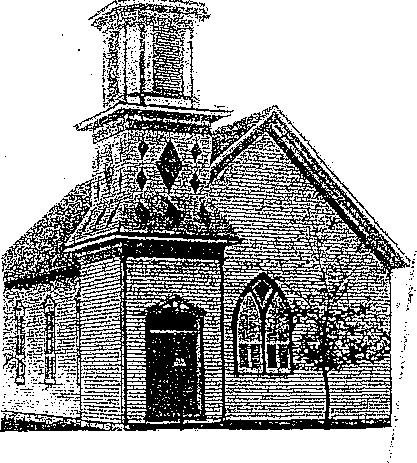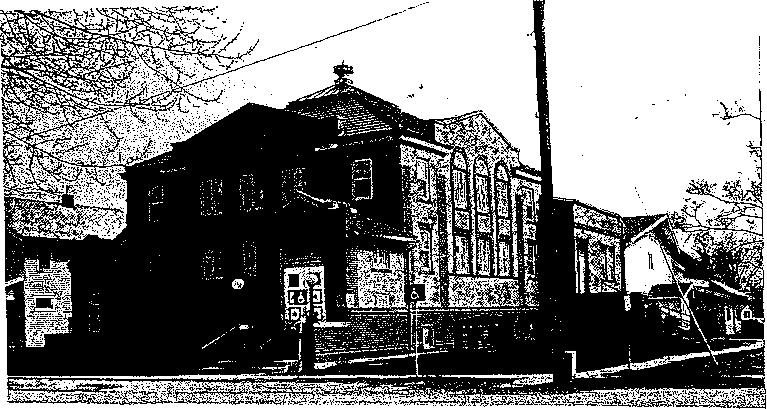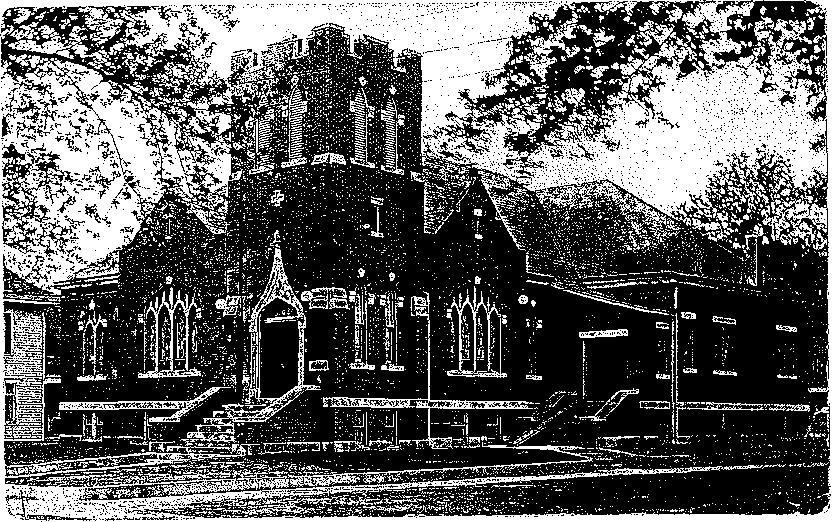MURRAY SCHOOL
The following report was compiled by Eva Mae Shannon and her 3rd grade students in 1986.
Soon after the town of Murray was organized, families saw the need for education. They were permitted to use the town's warehouse for this purpose. The walls were rough and nail kegs with planks served as benches. The teacher was Miss Lamb, a relative of Dr. George Armitage. The ABCs were taught with the rumbling of trains and the loading and unloading of freight at the opposite end of the warehouse.
The warehouse was also used by the Baptist people for church services. When the Baptist Church was built in 1869, school was held at the church, with Mr. Martindale as teacher for two terms. For a playground they had the territory on the south, literally clear to Missouri, as there were no fences.
In 1875, carpenters Jim Emery and Hi Lamb built a new school between the third and fourth blocks on Lyons Street. This was a two-room structure, although the upper room was not finished for immediate use. The first teacher in this facility was "Doc Turner." The curriculum was stretched in this building to provide a much better education. They had plastered walls, desks, blackboards, erasers, chalk, a globe and a wall map.
In 1881, the school added a four-year high school course. The following summer they added two rooms to the building, Mr. O. D. Cathels taking the contract. Mr. Jud Taylor taught for 4 1/2 years. Miss Tina Elliott was the principal. The class of 1885, with four students, were the first to complete high school. This frame building served as the school for 28 years, but was outgrown.
In 1898, it was decided to build a two-story, six room brick building at the cost of $9,000. In 1915, they excavated a basement and added a manual training building. By 1924, this building seemed inadequate and another new building was planned.
On April 13, 1925, with only six weeks of school left, the old building burned. Classes were completed in buildings, churches, and two rooms of Dr. Armitage's house. The following fall, school started in a new building with an enrollment of 220 students.
In the fall of 1925, a new building was ready for classes. Not much reconstruction was done to the building for a few years. In 1958, a new gym was added to the south end of the building. A two-room concrete block building was built west of the gym to be used as a Vocational Agriculture room. In 1960, a country school house was moved south of the Voc-Ag building. It was redecorated and used as a special ed room. Later it was used as a band room.
In 1978, much reconstruction was done to the main building making larger and nicer classrooms. Then another section was added to the south end of the building, which consists of a lovely kitchen, multipurpose room, office and more large classrooms.
In 1983, a new section was added to the north end and side of the main building. This was an all new Voc Ag and industrial arts department with much new equipment and classrooms. The present enrollment (in 1986) at Murray Community School is 307. There are 30 faculty members.
The school and community work very well together. The community has organized a Boosters Club, Lions Club, two sorority groups, Murray Betterment Club, a Band Boosters Club, an Athletic Boosters Club, and three very active churches all which help to make a better school and community. Summer programs consist of baseball, softball, Little League, and C.R.D. programs, which involves teachers and volunteers working with parents and students.
MURRAY BAPTIST CHURCH
Sent by Joan Callison, taken from the 1993 Quasquicentennial Book
The Baptist Church was organized in 1868, in the railroad warehouse. Their services were held monthly, and also a union Sunday school was organized. The Church building was erected in 1870, at a cost of $500. It was located on the site of the present parsonage and faced the north. It was the property of the Baptists but in its early years was also used by the Congregationalists, until they were disbanded and by the Methodists and Disciples until they build their own houses of worship.
The church had straight-backed benches, the walls and ceiling were covered with brown builders' paper held to the framework by long strips. The few coal lamps in wall brackets gave just enough light to prevent a man from making the awful mistake of sitting down on the women's side or vice versa. The sheet iron stoves had a habit of diffusing the heat unequally.
In 1876, the Baptists and Christians held church on alternate Sundays., As improvements were made to the church, pews were added and were painted a light gray, and there was a sort of partitions through the center of the church.
According to the Murray Democrat January 1, 1915, the present structure was erected at the cost of $2200.
The church has ordained several to the ministry — among them the Rev. Wimmer Lewis and M.C. Perry who later were missionaries to Burma. The membership decreased through the years and the church was sold in 1957, becoming the Murray Bible Church.
In 1970, an addition was built on to the church by its members. The addition consisted of a large classroom and kitchen. On November 15, 1972, a vote of the membership was held and the Murray Baptist Church was formed. It is associated with the General Association of Regular Baptist Churches. In 1972, the sanctuary was paneled and carpeting was installed in the summer
of 1975. The church was also furnished with new pews at this time.

Church Built 1893 |
|
A new addition to the church was begun in July 1976, when a basement was dug. It is located beside the present building. Sunday school classes, a kitchen, and a fellowship hall are located here. A sanctuary was added to the existing basement in 1988.
The mission of the Murray Baptist Church is to further the Gospel Christ.
A new auditorium was built in 1994. The old church building was torn down in 1995. |
|

MURRAY CHURCH OF CHRIST 1873-1973
By Joan Callison
My family and I have been personally involved in Murray and her history from very early years. My Great-Great Grandfather, John Turner, held meetings in his home before there was a church, he was an elder in the first church and there are currently at least 10 of his descendants who are members of the church.
When my Great Grandparents, Charles and Rebecca Daniel were married in 1979 (editors note: this date is likely 1879), Joseph gave them, as he did all of his sons when they married, 80 acres of land, a team of horses, a cow, and a pig or two, telling them that was all they were going to get. It was a great start in those days. Murray became a town in 1868. I live in part on the farm purchased by Joseph Daniel that same year.
The Christian church was organized June 6, 1873, by Elder Cary, with a small
membership. Services were held in a hall and in private houses, and later in the Baptist church. In 1876, the Baptist and Christian people held services alternate Sundays. The old Baptist Church was truly a barnlike structure. The seats were straight-backed benches, the walls and ceiling covered with brown builder's paper held to the framework by long strips. The few coal oil lamps in wall brackets gave just enough light to prevent a man making the awful mistake of sitting down on the women's side or vice-versa. The sheet iron stoves had a habit of diffusing the heat so unequally that nearby sinners could well imagine themselves already consigned to the "unquenchable fire." Sunday school was held at noon as Baptists had the regular ten o'clock hour.
J. C, White ministered here and at Hopeville for several years beginning in 1876 . He came by train and rode with the mailman when he went to Hopeville. It's thought a Brother Morris was the second preacher and a Mr. Branch was here around 1884. Mr. Branch preached the funeral of John L. Turner. one of the first elders in the church.
In 1891, the church had grown sufficiently strong to build a home for themselves and a structure was erected on South Maple Avenue. The church was dedicated by F.M. Rains. This building was used for 24 years. The Ladies Aid prepared a supper in the church, raising over $100 which was used to purchase a bell for the church. Mr. Landis, whose wife was president of the Ladies Aid, and Joseph Daniel went to Des Moines and selected the bell which hung in its tower until 1915, when the building was razed. The bell was silent until 1923, when the Ladies Aid bought a tower and had it set just outside the southeast corner of the new church.
In the summer of 1915, members began to talk about a new church. September 12, 1915, was the last time services were held in the old church. During this time, services were held in the Gem Theater. On August 8, 1915, a new church was assured at the Christian Church rally in a large tent secured for the occasion. An estimated 600 were in attendance, and pledges of $13,000 were secured for the building and a gift by the Frank Bossermans of $1,200 for a new pipe organ. Operations for the new church were begun September 1. Work was abandoned in the fall, construction resuming in the spring and work rushed through to completion.
April 6, 1916, a large gathering of citizens witnessed the laying of the cornerstone. Pictures of charter members — Mrs. F.H. Bishop, Mrs. M.L. Holcomb, Mrs. J.E. Wick,and Mrs. Hiram Lamb, were placed in the cornerstone with a copy of the church history and officials, and a Murray News of recent print.
The fall of 1916, marked the beginning of a new era in the history of the church. The $23,000 brick structure with its pipe organ, spacious auditorium with balcony, comfortably seating 500, its classrooms, full basement, dining room and kitchen, boasted the modern conveniences of electric lighting and a hot air system. The parsonage and church were completed and the date set for dedication. On November 12, 1916, S.C. Cauble of Indianapolis, Indiana, was master of ceremonies for the event with J.E. Ogden in charge of the music. $10,567 was raised by pledges and the new church was dedicated free of debt. At the evening service November 20, 1927, the note was burned, the $14,000 indebtedness was paid.
Outstanding notations were made through the years: Between 1930 and 1931, Leslie Ross built a young people's Sunday School class of over 100 members and a small orchestra was organized.. Cecil Murrow was pastor in 1939, and Mrs. Murrow organized a Junior Choir who wore white robes provided by the ladies of the church. In 1941, we replaced the old furnace, and on November 9 or that year the 25th anniversary of dedication was observed. These were Depression years with banks closing, a drought, and the 2nd World War was involving our young people. The timing was right for the coming of the enthusiastic Everett Epperson in 1942. His youth, vitality and eagerness to preach caused constant advances to be made in the church.
On November 22, 1953, the 80th anniversary was observed by a harvest dinner and afternoon program. At this time the youth sponsored a series of revival meetings. A new gas furnace was installed in February 1955, at a cost of $2,333. In 1966, a new spinet piano was purchased for the church sanctuary by donations from members and interested friends. On January 16, 1968, Murray church services were conducted over KRNT-TV.
In the Murray's Centenniel year, 1968, on March 11 the church held an appropriate observance. In that year the congregation voted unanimously to have the church name removed from the annual yearbook of the Disciples of Christ.
MURRAY METHODIST CHURCH
Sent by Joan Callison, taken from the Centennial Book 1968, Murray
In 1867, before Murray was actually a town, the people of the outlying area saw the need of the organization of a Methodist Episcopal church. Arrangements were made with Rev. John Dailey of Osceola, who was called a "circuit rider," to come to the Pennal school house in Troy Township and organize a Sunday School and hold preaching services. There were 14 charter members.
The next year, 1868, the railroad was built and the town laid out. The following spring this group of Methodists moved from the schoolhouse to the railroad warehouse. In 1870, the Baptists built the first church in Murray, and the Methodist group was invited to worship with them.
In 1873, the first Methodist Church was built at a cost of $2,800. The church stood across the street southwest of the present location. Membership totaled 130. In 1888, Murray left the circuit and became a station.
The second church was built in 1894, at the cost of $3,500 on the site of the present church. During Rev.Taylor's ministry, our people undertook the task of a new modern building costing $35,000. It was dedicated May 30, 1920. A pipe organ was donated by Frank Bosserman for the new church and used for a number of years.
In 1967, the Methodist Church became part of the Clarke County Cooperative Methodist Ministry.
Return to main page for Recipes for Living 2011 by Fern Underwood
Last Revised February 15, 2015


